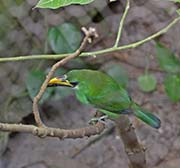Emerald Toucanet - Aulacorhynchus prasinus
| Length | |
| Weight | |
| Clutch Size | |
| Chicks at birth | |
| IUCN Conservation Status | |
Continents: |
A variety of races comprise Emerald Toucanets. Some of these races may be separate species. The pictures below are from the prasinus species and they are sometimes called the Mexican Emerald Toucanet.
Both sexes are similar but males are slightly larger and have a slightly larger bill. The body is mostly green and usually has a bronze-green crown. The vent and tail-tip are rufous. The upper bill is black and yellow with the amount of yellow depending on the sub-species. The lower bill is black. In some sub-species a white band is at the base of the bill. In others this can be blue, black, etc. The eye ring can be blue, red or almost black. Juveniles are duller.
Emerald Toucanets are popular as pets and can learn tricks.
Diet: Emerald Toucanets search for food in pairs or small flocks. Fruit is an important part of their diet but they also eat flowers, insects, scorpions, spiders, bird eggs, lizards and snakes.
Courtship: Courtship rituals include nodding, head-jerking, and tail-cocking.
Nesting: The nest is usually built in a rotten wood or reuses a nest from other species such as woodpeckers. Further excavation may be needed which is mostly done by the female. The female lays 3-4 white eggs and both incubates and feeds them after hatching.
Habitat and Range: Emerald Toucanets are found from Mexico to Venezuela. They roost in tree and branches in humid montane forests, forest edges, plantations, etc.
Vocalization: Prolong series of barking to growling noises.
Plumage/Molt: Emerald Toucans do not have a breeding plumage. There is no information on the frequency of their molt.
Migration: Non-migratory.
Tongue/feet: Emerald Toucanets have gray feet and legs.
Bibliography:
- http://en.wikipedia.org The Free Encyclopedia, Accessed July, 2013
- http://animaldiversity.ummz.umich.edu/site/index.html Animal Diversity Web, Univ. of Michigan Museum of Zoology, Accessed July, 2013
- del Hoyo, Josep, Elliott, Andrew, Sargatal, Jordi, et.al., Handbook of the Birds of the World,Lynx Edicions

